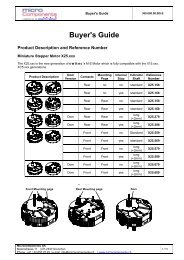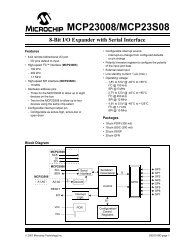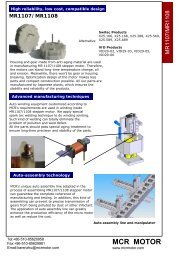VID29 Series Data Sheet - Guy Carpenter
VID29 Series Data Sheet - Guy Carpenter
VID29 Series Data Sheet - Guy Carpenter
Create successful ePaper yourself
Turn your PDF publications into a flip-book with our unique Google optimized e-Paper software.
DESCRIPTION<br />
<strong>VID29</strong> <strong>Series</strong> Stepper Motor<br />
© 2006 <strong>Data</strong> Instrumentation Technology Limited.<br />
Email: vid.info@wellgain.com | Website: www.vid.wellgain.com<br />
Type:<strong>VID29</strong>-XX/XXP<br />
Revision:1<br />
Page 1 of 10<br />
<strong>VID29</strong>-XX and <strong>VID29</strong>-XXP series is a precise stepping motor of patent design, with gear<br />
reduction ratio 180/1, mainly used in dashboard instrumentation or other digital indicator<br />
equipments, to transfer digital signals directly and accurately to analog display output.<br />
Driven by 2 sequent logic pulse signals in 5V-10V, the output shaft can reach stepping angle<br />
resolution 1/12°. The angular speed can reach more than 500Hz.<br />
The new and modern design makes high efficiency, high position accuracy and extremely robust<br />
gear system. The special gear shape is helpful to decrease friction and noise. It chooses special<br />
material for each component to increase liability and safety for the motor.<br />
FEATURES<br />
- Wide working voltage: 5~10V.<br />
- Low current consumption: less than20mA, 5V, 2X100mW.<br />
- Wide working temperature: -40~105℃.<br />
- Extremely robust construction: Ф30mm X 7.6mm.<br />
- High μ-step resolution: 1/12°.<br />
- Directly driven by a μ-controller.<br />
TYPICAL APPLICATION<br />
signals CPU<br />
motor<br />
driving<br />
circuit<br />
0<br />
10<br />
20<br />
display<br />
perfect combination of digital accuracy and analog facility<br />
30
STEP DEFINITION AND ROTOR MOVEMENT<br />
© 2006 <strong>Data</strong> Instrumentation Technology Limited.<br />
Email: vid.info@wellgain.com | Website: www.vid.wellgain.com<br />
Type:<strong>VID29</strong>-XX/XXP<br />
Revision:1<br />
Page 2 of 10<br />
<strong>VID29</strong>-XX and <strong>VID29</strong>-XXP series motor are driven by 2 sequent logic pulse singnals. Its work<br />
diagram is as following:<br />
Pulse sequence<br />
Full 180 。<br />
U L<br />
U R<br />
Partial 60 。<br />
+5V<br />
0<br />
-5V<br />
+5V<br />
0<br />
-5V<br />
1 2 3 4 5 6 1 2 3 4 5<br />
micro 15 。<br />
Full Step Partial Step<br />
One cycle<br />
Gear ratio 1/180<br />
UL<br />
1<br />
2 3<br />
Rotor Gears Motor Output<br />
In order to make motor run more stable and decrease the noise, micro stepping technology is<br />
recommended. The micro pulse sequence which is more precise and near to sine wave, which<br />
could drive motor with 1/12º micro step of the pointer. The diagram is as following:<br />
Pulse sequence<br />
Voltage in<br />
coil<br />
+5V<br />
0<br />
-5V<br />
1 2 3 4 5 6 1 2 3 4 5<br />
Full Step Partial Step<br />
One cycle<br />
4<br />
UR<br />
Micro Step<br />
For more details about the micro stepping driving signals, please see specified files.
ABSOLUTE MAXIMUM RATINGS<br />
Driving voltage (Ub)..............…………………………...........10V<br />
EMI tolerance (1 kHz;AM 80%; 100 kHz - 2 GHz) ....….......80 V/m<br />
Solder temperature (10 sec).........………………....... ....... ...260ºC<br />
© 2006 <strong>Data</strong> Instrumentation Technology Limited.<br />
Email: vid.info@wellgain.com | Website: www.vid.wellgain.com<br />
Type:<strong>VID29</strong>-XX/XXP<br />
Revision:1<br />
Page 3 of 10<br />
ELECTRICAL AND MECHANICAL CHARACTERISTICS<br />
Tamb=25ºC, In micro step mode @ Max. voltage 4.2V, unless other specified.<br />
Parameter Symbol Test Conditions Min. Typ. Max Units<br />
Electrical Characteristics<br />
Operating Temperature Ta -40 105 ºC<br />
Coil Resistance Rb 260 280 300 Ω<br />
Operating Current Im fa=200Hz 15 20 mA<br />
Start-Stop Frequency fss JL=0.2x10 -6 kgm 2 125 Hz<br />
Maximum Driving<br />
Frequency<br />
Mechanical Characteristics<br />
fmm JL=0.2x10 -6 kgm 2 600 Hz<br />
Dynamic Torque M200<br />
fa=200Hz 1.0 1.2 1.4 MNm<br />
M400<br />
fa=400Hz 0.7 0.85 1.0 mNm<br />
Static Torque Ms Ub=5V 3.5 4.0 mNm<br />
Equivalent Motor Inertia<br />
@ Output<br />
Jm<br />
4.225<br />
E-7<br />
Gear ratio 180 :1<br />
Kgm 2<br />
Step size in full step mode 1 Degree<br />
Step size in partial step<br />
mode<br />
Step size in micro step<br />
mode<br />
Noise<br />
Others<br />
1/3 Degree<br />
1/12 Degree<br />
Backlash 0.5 1.0 Degree<br />
Noise Level<br />
SPL<br />
@ 100 °/sec<br />
@ 200 °/sec<br />
@ 400 °/sec<br />
34<br />
41<br />
44<br />
dBA<br />
dBA<br />
dBA<br />
Angle of Rotation fl Motors with internal 315 Degree
Force allowed on the<br />
pointer shaft:<br />
Axial force (push)<br />
Axial force (pull)<br />
Perpendicular force<br />
Imposed acceleration<br />
Fa<br />
Fa<br />
Fq<br />
Note: fa – full-step frequency JL – Load inertia<br />
Stop<br />
TYPICAL TORQUE AND NOISE<br />
Torque in micro step driving mode, @ Max voltage Ub= 4.2V<br />
Noise in micro step driving mode, @ Max voltage Ub= 4.2V<br />
© 2006 <strong>Data</strong> Instrumentation Technology Limited.<br />
Email: vid.info@wellgain.com | Website: www.vid.wellgain.com<br />
αp<br />
Type:<strong>VID29</strong>-XX/XXP<br />
Revision:1<br />
Page 4 of 10<br />
Unit: Unm.<br />
150<br />
70<br />
12<br />
1000<br />
Unit: dB.<br />
N<br />
N<br />
N<br />
Rad/s2
PIN CONNECTION<br />
Schematic<br />
Schematic<br />
SUGGESTED INSTALLATION<br />
© 2006 <strong>Data</strong> Instrumentation Technology Limited.<br />
Email: vid.info@wellgain.com | Website: www.vid.wellgain.com<br />
Type:<strong>VID29</strong>-XX/XXP<br />
Revision:1<br />
Page 5 of 10<br />
The <strong>VID29</strong> can be easily installed. The four contact pins can be soldered on PCB circuits. If the<br />
application is subject in very strong vibrations, screws might be necessary.<br />
Installation Diagram<br />
<strong>VID29</strong>-XX Pin Connection<br />
4<br />
3<br />
Front Mount<br />
<strong>VID29</strong>-XXP Pin Connection<br />
1<br />
2<br />
Front Mount<br />
1<br />
2<br />
4<br />
3<br />
4<br />
3<br />
1<br />
2<br />
Rear Mount<br />
Rear Mount<br />
1<br />
2<br />
4<br />
3
APPLICATION HINT<br />
© 2006 <strong>Data</strong> Instrumentation Technology Limited.<br />
Email: vid.info@wellgain.com | Website: www.vid.wellgain.com<br />
Type:<strong>VID29</strong>-XX/XXP<br />
Revision:1<br />
Page 6 of 10<br />
The parameter of the pointer:<br />
Min Typical Suggested<br />
MaxValue(*)<br />
Size: 50mm 80mm<br />
Weight: 2.5g 10g<br />
Inertia moment: −7<br />
2<br />
2× 10 kgm<br />
20× 10 kgm<br />
−7<br />
2<br />
Unbalance: 0.01mNm 0.025mNm<br />
DRIVING PULSE AND CONTROL CIRCUIT<br />
Partial-Step Driving Mode<br />
In partial-step driving mode, the motor can be directly driven by a standard logic voltage level with<br />
less than 20mA current consumption. The bit-time sequence determines the turning direction of<br />
the motor. The time sequence diagram is as following:<br />
Driving Pulse in Partial Mode<br />
Bit Map<br />
Contact 1<br />
Contact 2,3<br />
Contact 4<br />
Coil Voltage U L<br />
Coil Voltage U R<br />
1<br />
0<br />
1<br />
0<br />
1<br />
0<br />
Pulse Sequence<br />
0<br />
0<br />
1 2 3 4 5 6 1 2 3 4 5<br />
1<br />
2<br />
4<br />
3<br />
Clockwise (for <strong>VID29</strong>_xxP)<br />
Counterclockwise (for <strong>VID29</strong>_xx)<br />
Counterclockwise (for <strong>VID29</strong>_xxP)<br />
Clockwise (for <strong>VID29</strong>_xx)<br />
U L<br />
U L<br />
<strong>VID29</strong>_xxP<br />
<strong>VID29</strong>_xx<br />
U R<br />
U R<br />
4<br />
3<br />
1<br />
2
Driving Diagram in Partial Mode<br />
VDD<br />
GND<br />
U L<br />
μ-Step Driving Mode<br />
1 2 3 4<br />
© 2006 <strong>Data</strong> Instrumentation Technology Limited.<br />
Email: vid.info@wellgain.com | Website: www.vid.wellgain.com<br />
U R<br />
Type:<strong>VID29</strong>-XX/XXP<br />
Revision:1<br />
Page 7 of 10<br />
In μ-step driving mode, the motor can be driven by a current-level sequence. A μ-step is a 0.083º<br />
of pointer. The driving pulses consist of many different current level pulse sequences. The μ-step<br />
provides the pointer shaft continuous, smooth movement.<br />
Example of driving Pulses in μ-step Mode<br />
Pulse () i<br />
Pulse ( i+ 4)<br />
20<br />
16.67<br />
13.33<br />
10<br />
6.67<br />
3.33<br />
0 1 2 3 4 5 6 7 8 9 10 11 12 13 14 15 16 17 18 19 20 21 22 23 24<br />
3.33<br />
6.67<br />
-Step1<br />
-Step2<br />
10<br />
13.33<br />
16.67<br />
20<br />
Step6 Step5<br />
Step4<br />
Drivering pulse for micro-step(Current amplitude=16.07mA)<br />
Step3<br />
Current Left in the left coil<br />
Current<br />
Right<br />
in the right coil<br />
Step2<br />
Step1<br />
-Step3<br />
i<br />
-Step4<br />
-Step5 -Step6<br />
In general the peak amplitude should be between 12.9mA and 16.07mA.
1<br />
2<br />
U L<br />
<strong>VID29</strong>_××P<br />
U R<br />
ACCELERATION PROCESS<br />
4<br />
3<br />
Clockwise( <strong>VID29</strong>_××P)<br />
CounterClockwise(<strong>VID29</strong>_××)<br />
CounterClockwise(<strong>VID29</strong>_××P)<br />
Clockwise(<strong>VID29</strong>_××)<br />
© 2006 <strong>Data</strong> Instrumentation Technology Limited.<br />
Email: vid.info@wellgain.com | Website: www.vid.wellgain.com<br />
4<br />
3<br />
U L<br />
Type:<strong>VID29</strong>-XX/XXP<br />
Revision:1<br />
Page 8 of 10<br />
<strong>VID29</strong>_xx<br />
In most of the <strong>VID29</strong>-XX applications, the angular range of the instrument dial is less than 300°.<br />
This allows to using mechanical stop to define the zero position. Generally the pointer will be<br />
reset to the zero position at each time power-up process.<br />
In power-up process, to quickly drive the pointer onto his initial stop position without creating<br />
visible and audible jitter of the pointer, we suggest a frequency acceleration process to speed<br />
up <strong>VID29</strong> step motor till a high speed. Below is an example:<br />
100000<br />
80000<br />
60000<br />
40000<br />
20000<br />
speed of rotor<br />
deg/sec<br />
500<br />
400<br />
300<br />
200<br />
100<br />
speed of<br />
pointer<br />
deg/sec<br />
Acceleration phase<br />
Star-stop frequency<br />
10 20 30 40 50 60<br />
5 10 15 20 25 30<br />
1000 3000 4000 6000<br />
Final speed<br />
U R<br />
1<br />
2<br />
Time (ms)<br />
angle of pointer<br />
angle of rotor
RELIABILITY TEST<br />
Temperature Cycle Test<br />
- Low Temperature: -40°C±2°C<br />
- High Temperature: +105°C±2°C<br />
- Dwell time: each for 1 Hrs<br />
- Transfer Time: 1.5 hrs<br />
- Cycle times: 50 cycles total 300hrs<br />
- Cycle mode: see right graph..<br />
- Motor Status: running<br />
- Reference standard: IEC60068-2-14.<br />
Thermal Shock Test<br />
- Low Temperature: -40°C±2°C<br />
- High Temperature: +105°C±2°C<br />
- Dwell time: each for 0.5hrs<br />
- Transfer Time: within 30s<br />
- Cycle:100 Cycles total 100hrs<br />
- Motor Status: non-running<br />
- Reference standard: IEC60068-2-14.<br />
Humidity Test<br />
- Temperature:+65°C±2°C<br />
- Humidity:95±2%RH<br />
- Duration:144 Hrs<br />
- Motor Status: non-running<br />
- Reference standard: IEC68-2-3.<br />
High Temperature Test<br />
- Temperature: +105°C±2°C<br />
- Duration:168 Hrs<br />
- Motor Status: running<br />
- Reference standard: IEC60068-2-2.<br />
Low Temperature Test<br />
- Temperature: -40°C±2°C<br />
- Duration: 48 Hrs<br />
- Motor Status: running<br />
- Reference standard: IEC68-2-1.<br />
© 2006 <strong>Data</strong> Instrumentation Technology Limited.<br />
Email: vid.info@wellgain.com | Website: www.vid.wellgain.com<br />
Type:<strong>VID29</strong>-XX/XXP<br />
Revision:1<br />
Page 9 of 10<br />
Mechanical Vibration Test<br />
- Pulse shape: sine pulse form<br />
- Range of frequency: 10Hz~<br />
200Hz(logarithm sweep)<br />
- Sweep cycle: 300 sec.<br />
- Direction: X,Y axis<br />
- Duration:8 hrs /each Direction<br />
- Acceleration: 6 g<br />
- Motor Status: running<br />
- Reference standard: IEC60068-2-6<br />
Mechanical Shocking Test<br />
- Height: 1.2 m<br />
- Direction: X/Y<br />
- Motor Status: non-running<br />
- Reference standard: IEC68-2-62
PACKING SKETCH MAP<br />
Tray for 100 stepper motors <strong>VID29</strong><br />
Material : PP<br />
Weight : Tray<br />
1x210g=210g<br />
Motors 100x7g=700g<br />
Total = 910g<br />
Stack for 1000 motors <strong>VID29</strong>:<br />
Material : 11Trays (including Cover)<br />
strappedtogether with plastic band<br />
Weight : Trays 10x910g=9100g<br />
Cover tray 1x210g=210g<br />
Plastic strap 2x15g=30g<br />
Total = 9340g<br />
Master-carton for 1000 motors <strong>VID29</strong>:<br />
Material : cardboard 710g/m<br />
Weight : Master-carton 1x900g=900g<br />
PE bag 2x50g=100g<br />
Production 1x9340g=9340g<br />
PE 4x60g=240g<br />
Total 10580g<br />
A cardboard of motors 10580g<br />
Plastic strap 2x15g=30g<br />
Total 10620g<br />
© 2006 <strong>Data</strong> Instrumentation Technology Limited.<br />
Email: vid.info@wellgain.com | Website: www.vid.wellgain.com<br />
Type:<strong>VID29</strong>-XX/XXP<br />
Revision:1<br />
Page 3 of 10















